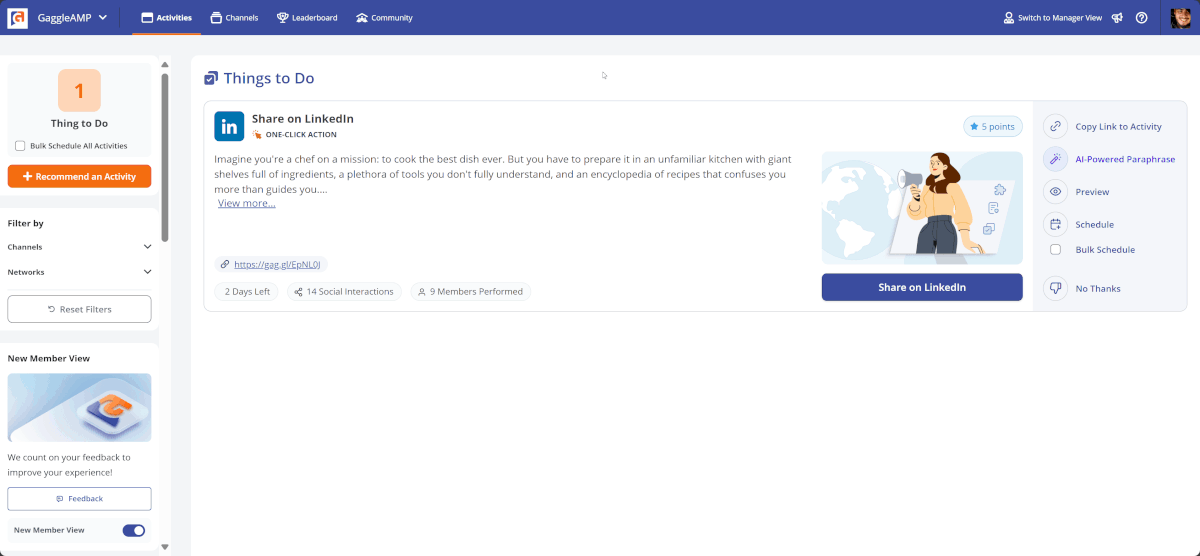Creating a constant stream of original content (articles, videos, social media posts) can be exhausting, especially if you have limited resources and manage multiple social platforms. A smarter way to extend the reach and engagement of your content strategy is through curation.
Content curation refers to the identifying, gathering, packaging, and sharing of relevant content from other sources instead of developing your own. It involves adding your perspective, insights, and commentary to content that’s already out there and presenting it to your audiences in a way that keeps them coming back for more.
What makes content curation so popular is that it provides value to audiences while positioning the curator as a thought leader in a particular industry while simultaneously saving them time and resources.
Are you keen to tap into the power of content curation?
This comprehensive guide will teach you everything you need to know to get started and transform your online presence!
Curation vs. Creation
While content creation involves generating original material from scratch, content curation involves selecting, organizing, and sharing existing content in keeping with your brand message and audience interests. Where they intersect is with the audience they wish to attract.
If content creation is baking a cake from scratch, content curation is assembling a dessert platter with top picks from multiple bakeries. And the taste tester? That’s your audience.
Both have their place in a well-rounded content strategy.
Benefits of Content Curation
Content curation does a lot more than fill gaps. It can help you:
- Save Time and Money: Creating high-quality content takes time and resources. Curating content allows you to fill your content calendar without stretching your team or budget thin.
- Build Relationships: Sharing and crediting content created by others is a great way to build relationships with industry peers, thought leaders, and potential partners. It fuels a two-way street of appreciation and support.
- Diversify Your Content Calendar: Even after you’ve poured in plenty of resources, there’ll always be a limit to your content’s range. Keep your feed fresh and exciting by curating from diverse sources —- different topics, perspectives, formats, and more.
- Engage Your Community: Curated content can spark conversations by inviting your audience to join you in sharing their thoughts and opinions. Well-curated content attracts and builds an invested community.
- Be a Thought Leader: By consistently sharing high-quality, relevant content, you establish yourself as a trusted source of information and insights in your industry. This attracts audiences organically and boosts your brand reputation.
Now, let’s go over setting up your content curation strategy.
Setting Up Your Content Curation Strategy
Content curation isn't about aimlessly sharing articles you stumble upon. It's a strategic process that requires careful planning and execution.
Here's how to build a content curation strategy that aligns with your brand goals.
1. Define Your Audience
Get specific about your ideal customer and identify their interests, pain points, and challenges.
Let's say you run a B2B SaaS company specializing in project management software. In this case, your target audience might be project managers and team leaders in mid-sized companies who need help to keep projects on track and under budget.
2. Perform Topic Research
Once you know your audience, dive into their conversations.
What questions are they asking on social media or industry forums?
An example of a post we’d be interested in from B2B Marketing Community, Exit Five.
Use keyword research tools, social media listening tools, and industry publications to find answers. For example, tools like BuzzSumo uncover trending topics.
3. Decide on a Content Curation to Creation Ratio
Semrush recommends starting with a 50/50 mix of curated and original content and then experimenting until you find the ideal ratio for your team.
Some brands, however, might curate 80% and create 20%. It’s all about finding the right balance, and experimentation is the only way to do that.
4. Create Relevant Content Categories
Categorize your content to match your brand’s focus areas. This makes it easier for your audience to find content that interests them and helps you maintain a cohesive brand message.
For instance, our hypothetical project management SaaS company could create categories like ‘Productivity Hacks,’ ‘Team Collaboration Tips,’ and ‘Industry News & Insights.’
Each category would then house a mix of curated articles, blog posts, social media posts, and original content from the company.
Finding and Sourcing Content
Finding, sourcing, and sharing the right content is the crux of curation!
Content curation can be a treasure hunt. Here's how to unearth the gems.
- Follow Resources on Social Media: Industry leaders, competitors, popular accounts in your niche, and, in some cases, even meme pages about your industry —- they can all be excellent sources of inspiration. Remember to track multiple social media platforms.
- Subscribe to Newsletters and Publications: Subscribe to influencer, company, and industry newsletters and read relevant publications. This ensures a steady stream of ideas for both original and curated content.
- Use Content Curation Tools: Tools like Feedly help you aggregate content from multiple sources in one place. Google Alerts notifies you when new content is published on specific topics you're interested in.
- Leverage User-Generated Content: Your audience is the best source of authentic content. Encourage them to share their experiences, reviews, and opinions about your brand or industry. According to Nielsen, 88% of consumers trust recommendations from people they know above all other forms of marketing messaging.
- Utilize Media Monitoring Tools: Tools like Mention track brand mentions and relevant web and social media keywords, helping you identify relevant topics and discover valuable content.
Best Practices for Content Creation
We’ve made a cheat sheet to help you curate content that resonates with your audience. The following guidelines will help you create an effective and ethical content curation process.
- Mix It Up: Don't just share articles. Blend in videos, infographics, podcasts, and social media posts.
- Know Your Crowd: Choose content that speaks directly to your audience's interests and pain points.
- Explore Different Sources: Cast a wide net! Look beyond blogs to find unique and engaging content.
- Add Your Spin: Don't just repost. Share your thoughts, opinions, or a relevant question to spark conversations.
- Give Credit Where It's Due: Always credit the original source. It's good etiquette and builds relationships.
 Source: LinkedIn
Source: LinkedIn
- Plan Ahead: Use a content calendar to schedule your curated content to maintain consistency.
- Measure and Improve: Track engagement metrics to see what resonates with your audience. Use these insights to refine your strategy over time.
Tools for Content Curation
Let's be real: manually sifting through endless content is a time killer. With these tools, you’ll curate smarter, not harder, and achieve better results.
- Hootsuite: This social media platform is for more than just scheduling posts. Use it to monitor keywords, track trending topics, and discover shareable content across multiple platforms.
- BuzzSumo: Find out what's hot and what's not. BuzzSumo reveals the most shared content on any topic.
- Scoop.it: This tool curates content based on your chosen topics and delivers it straight to your dashboard. You can easily share curated content to your social channels or create your own online magazine.
- Curata: Designed for enterprise-level curation, Curata offers a powerful suite of features, including content discovery, automation, and analytics. It's a great option for teams who need a robust curation solution.
- Feedly: This RSS reader lets you follow your favorite blogs, news sites, and publications in one place. You can use it to browse and share articles, making it a great tool for staying on top of your industry.
- Quuu: This AI-powered tool specializes in understanding your brand's tone and audience to curate more relevant content.
- Pocket: This Chrome extension collects articles, videos, and other web content for later reading. Pocket makes building a cross-platform library of curated content easy.
Distributing Curated Content
You've found the perfect pieces of content. Now it’s time to ensure they reach their target audience and keep spreading. Here are a few ways you can effectively distribute content.
1. Social Media Platforms
This is a no-brainer. Identify which platforms your target audiences use and concentrate your efforts there. Your posts should match each platform's unique vibe and audience.
Success on social media platforms, including LinkedIn, X, Facebook, and Instagram, requires regularity, consistency, and keeping an eye on trends.
2. Employee Advocacy
Tools like GaggleAMP turn your employees into a content-sharing army.
We found that 73% of social media managers report that employee advocacy doubles the brand's social media engagement, while 26% report that it triples it.
Employee advocates boost reach and authenticity as your team shares curated content with their networks.
3. Email Newsletters
Your newsletter subscribers expect regular, value-adding content. After all, everyone’s inbox space is limited!
Litmus found that emails drive an average ROI of $36 for every dollar spent, higher than any other channel. It’s something you can’t ignore.
Take the pressure off by distributing your curated content in email newsletters, keeping subscribers informed, engaged, and satisfied.
4. Blog Posts With Curated Links
Give your blog posts a boost by summarizing and linking to multiple pieces of curated content.
Share your insights and commentary to add value for your readers and enhance your site's SEO.
5. Content Aggregators
Platforms like Reddit and Medium are content hubs where you can share your curated finds and reach new audiences. Marketing teams often overlook these platforms, but they have incredible potential. Source: LinkedIn
Source: LinkedIn
In December 2023, Reddit alone had 73.1 million daily active users worldwide.
Posting curated content on these platforms can expose your brand to a broader audience and drive traffic to your website.
Industry-specific platforms like GrowthHackers are excellent if you’re looking to target professionals in growth, marketing, and product.
6. Webinars and Live Streams
In recent years, live streams have been gaining immense popularity.
Similarly, live workshops and webinars are dynamic, interactive channels for engaging your audience. Invite experts, host Q&A sessions, and foster real-time conversations around hot topics.
Your sessions don’t have to be based on original research or insights – you can prepare, share, and discuss curated content.
Case Studies of Master Curators
To get a better picture of content curation in action, let’s look at a couple of brands that have mastered the art.
Morning Brew
Morning Brew’s entire content strategy is built around curation. The company set out to deliver insights and updates about the business world but went on to cover much more.
What we can learn from Morning Brew is its ability to drill down into the crux of a news item to deliver a quick and engaging read. It reads like bite-sized journalism.
Often, Morning Brew adds a touch of humor or personality. Recently, it reported about luxury flying experiences designed for dogs. The article ended with this memorable quip: “Hopefully, turbulence doesn’t make it a ruff takeoff.”
Fun, right?
Morning Brew thrives by segmenting its brand into several verticals to ensure every audience gets what it wants and nothing else.
The company’s podcasts function as stand-alone features, including acquisitions like Money with Katie and the guest-heavy Imposters. These help it skip large parts of content production while adding significant value to audiences.
Aspiring content curators must also check out Morning Brew’s flagship newsletter for inspiration.
OpenView
OpenView is a venture capital firm focused on expansion-stage software companies that have crafted an excellent content curation strategy for its niche audience.
Here's how they cracked the code:
-
Understanding Their Audience: OpenView knows its audience inside and out: SaaS founders and executives hungry for actionable advice to scale their businesses. This clarity allows it to curate content that directly addresses the audience's pain points and aspirations.
-
Well-Defined Categories: OpenView content is organized into categories like ‘Company Development,’ ‘Customer Development,’ and ‘Product Development.’ This structure makes it easy for readers to find the exact information they need while positioning themselves as experts in distinct facets of SaaS growth.
-
Collaborative Curation: OpenView doesn't rely on a single curator. Instead, it leverages the collective knowledge of its team, with employees contributing articles and valuable resources. This collaborative approach ensures diverse perspectives and a steady stream of high-quality content.
-
Adding Value, Not Just Links: OpenView doesn't simply share links. They summarize key takeaways, offer their own analysis, and connect the dots between different pieces of content. This added layer of insight elevates curated content to a valuable resource for readers.
-
Active Engagement: OpenView actively participates in the conversation by encouraging comments and discussions on its blog posts. Over time, this has helped it build a vibrant community around curated content.
Avoid These Common Mistakes
In the excitement of all the things you can do, it’s important to note that there are certain things you shouldn’t do.
Pitfalls to avoid if you want to do content curation right:
- Over-Automation: Automated tools are great, but you shouldn’t rely too heavily on them. They can help discover content, but you need humans to make the finishing touches and final decisions to curate a meaningful collection.
- One-Size-Fits-All Approach: Don’t assume that all of your audiences want the same thing. Customize your curated content to fit your brand's voice and each audience’s interests. Categorizing content can help with this.
- Credit Snatching: Always give proper credit to the original source. This is not only ethical but also prevents potential conflict and helps you build relationships with other content creators.
 Source: LinkedIn
Source: LinkedIn
- Ignoring the Data: Publishing or sharing content doesn’t mean the job is done. You must track which curated content performs best and learn from your successes and failures.
Content Curation Carries You Forward
Content curation isn’t as simple as some might think. It's a strategic approach to building your brand, engaging your audience, and establishing yourself as a thought leader in your industry.
Have you felt stuck with your content marketing? Learning how to leverage curated content could be the path forward.
Anyone can do it —- you just need to invest the effort and time to devise and execute a good strategy.
But remember, the most impactful content doesn't just stay on your website or blog. It spreads like wildfire across the digital landscape, reaching new audiences and sparking conversations.
And that's where GaggleAMP comes in.
Amplify Your Curated Content With GaggleAMP
With GaggleAMP, you can turn your employees into a powerful distribution network, reaching audiences you could never reach alone.
We make it easy to share curated content with your team, engaging them and creating enthusiastic brand ambassadors.
Discover the power of employee advocacy and content curation. Get started with a free GaggleAMP trial today!











